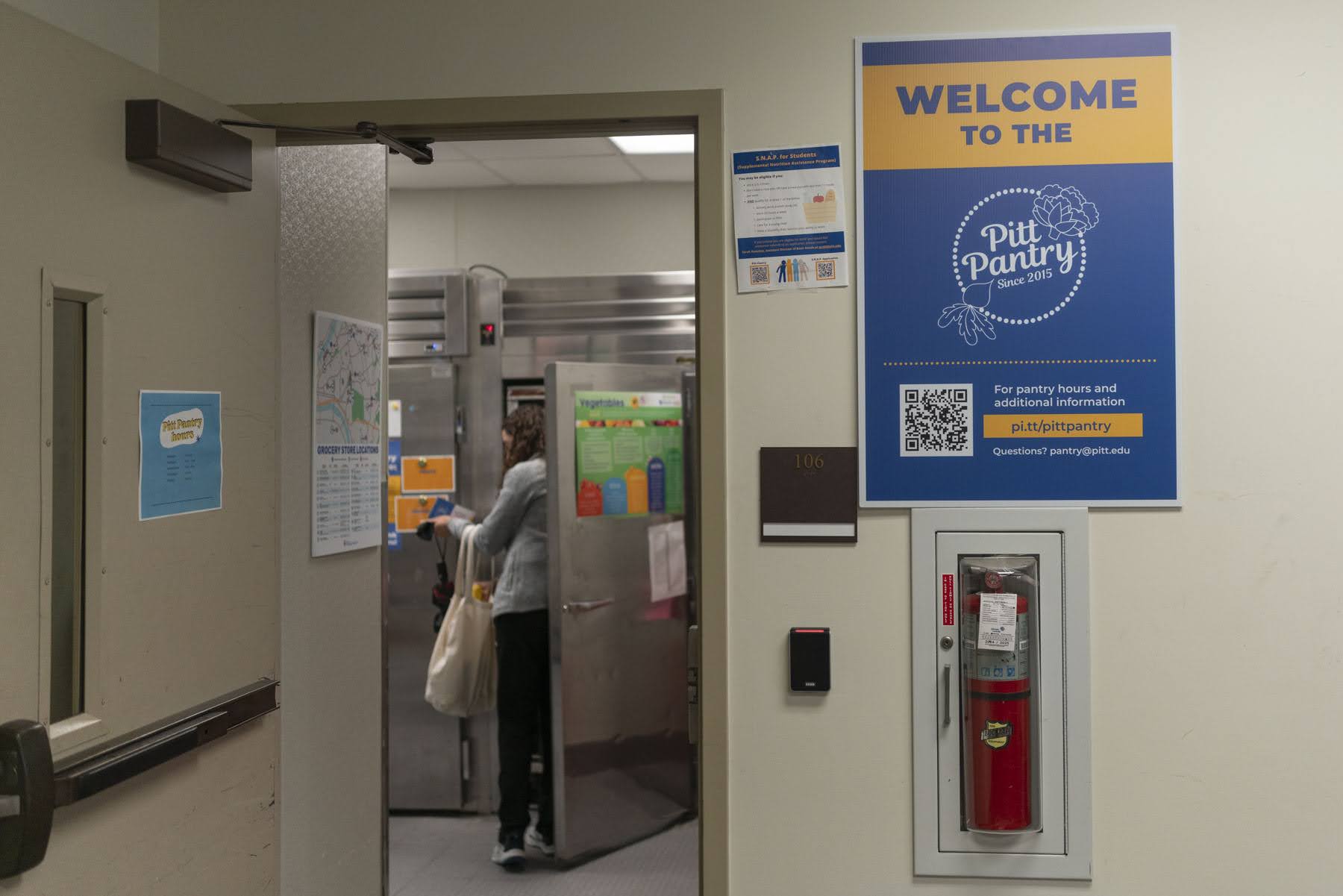2 N.C. colleges omitted from latest Helene relief bill

It's Friday, July 25, 2025 and in this morning's issue we're covering: Two N.C. colleges were omitted from the latest Helene relief bill, Current presidential administration canceled FEMA program that could have protected Hillsborough, N.C. from flooding, Pharmacies are disappearing across Pennsylvania as operators blame a broken payment system, Campus hunger may rise amid the ‘beautiful’ bill’s changes to SNAP food aid, How Arizona is lining up the next generation of election workers, as more people leave the field, Four years after cop was filmed slamming Black woman to the ground, Louisiana passes accountability law.
Media outlets and others featured: Carolina Public Press, Inside Climate News, Spotlight PA, Pittsburgh's Public Source, Votebeat, Verite News.
Why was Warren Wilson omitted from NC Helene bill’s aid to colleges?
by Kate Denning, Carolina Public Press
July 22, 2025
The most recent Helene recovery package from the state allocated $500 million to help address remaining damage to Western North Carolina, more than $4 million of which went to small private colleges and universities in the area. Even so, Warren Wilson College in Swannanoa, which says it sustained $12 million in damages, yet was not on the receiving end of any financial aid from the state.
The Swannanoa Valley in eastern Buncombe County experienced significant flooding from Helene with the river cresting at 26.1 feet, the highest point since 1916. Warren Wilson Provost and Dean of the Faculty Jay Roberts said 60 campus buildings experienced either roof or flood damage. FEMA and the Army Corps of Engineers helped remove 70,000 cubic yards of debris at the school. The campus did not have drinking or running water for a substantial amount of time, he said.
Warren Wilson President Damián J. Fernández issued a statement voicing his disappointment with the legislation’s exclusion of the college. He asked lawmakers to reconsider providing support when the legislature reconvenes later this month.
[Subscribe for FREE to Carolina Public Press’ alerts and weekend roundup newsletters]
Montreat College, located just 12 miles east of Warren Wilson, also experienced significant damage. Its gymnasium was the most impacted, and the college estimated it would take up to eight months to restore. Lees-McRae College in Banner Elk described its damage as moderate to Carolina Public Press in October. Three of its buildings were damaged by fallen trees, including a residence hall.
But Montreat and Lees-McRae each received $1.5 million in the latest relief package. In addition, Mars Hill University received $500,000. Brevard College, Gardner-Webb University and Lenoir-Rhyne University each received $250,000.
And despite initially being allocated $1.5 million when the House appropriations committee introduced the bill in May, Warren Wilson ultimately received nothing in the final version.
State representatives in the area are saying the change-up was a political move.
When the package was on the floor for a vote June 26, when it ultimately passed unanimously, state Rep. Lindsey Prather, D-Buncombe, pointed out Warren Wilson’s lack of funding. Prather represents the 115th district, where Warren Wilson resides.
“I’m confused and I’m disappointed and I’m very frustrated,” Prather said on the floor. “It certainly feels like the institutions in Buncombe — which as a whole, received the most amount of damage — are being carved out of this bill. I hope that this isn’t politicization of recovery. It’s hard not to read it that way.”
In addition to the lack of funding to Warren Wilson, Prather said an aspect of the funding allocated to the larger public universities also struck her as odd.
Western Carolina University and Appalachian State University both received $2 million, whereas UNC-Asheville, also located in Buncombe County, has to share its $2 million with the North Carolina Arboretum. The arboretum is an affiliate of the UNC System, but is not directly under UNC-Asheville or any individual institution.
Seeing as Montreat, a conservative religious college that is also located in Buncombe County, Prather told CPP these disparities make it seem as though institutions that are perceived as more progressive are being treated unfairly.
While Warren Wilson is affiliated with the Presbyterian Church and a member of the Association of Presbyterian Colleges and Universities, Roberts said he would describe the school as one with a historic religious affiliation rather than a religious college.
Warren Wilson was one of eight private colleges and universities included in the original bill proposed by the House. Johnson C. Smith University, an HBCU in Charlotte, was also initially positioned to receive $500,000 but was later removed. While Charlotte did not get the brunt of the storm, JCSU reported it had to close a residence hall due to water damage from Helene, leading the university to relocate more than 200 students.
When the legislation made its way to the Senate, all higher education institutions were stripped from the bill entirely. It wasn’t until the bill landed in the conference committee, a temporary joint committee created for the House and Senate to work out the bodies’ differences on a piece of legislation, that the six private schools and three UNC System schools made it in the final cut.
The conference committee was composed of four Republican representatives and four Republican senators. None of them responded to multiple requests for comment from CPP.
Prather said the makeup of the committee was disappointing but not surprising based on the current leadership in the legislature.
“Republican leaders in the legislature were the first to say that we all need to pull together for Western North Carolina and we can’t politicize this, we all need to support our brothers and sisters,” she said. “And then they go and form a conference committee with only Republicans, including some Republicans that don't live in Western North Carolina.”
State Rep. Eric Ager, D-Buncombe, represented Warren Wilson in past iterations of the state’s districts. Now the college falls under Prather’s jurisdiction, but it wasn’t easy for her to get there.
Ager believes it’s Prather’s election that made Republicans strip Warren Wilson from the recovery package.

When North Carolina was redistricted in 2023, Republicans used what Ager called a “donut strategy,” leaving Asheville as its own district in the middle and drawing two districts that lean more conservative, the 114th and 115th, around the city. Despite the 115th district appearing to be a Republican stronghold, Prather won the seat by a tight margin in 2024.
It’s hard to see any other reason why Warren Wilson was left out of Helene funding than politics, Ager said.
“That’s the only reason I can think of that makes Warren Wilson different, because the reality of it is they suffered a lot more damage than the other schools that were on the list,” he said.
Warren Wilson leaders were surprised by the college’s exclusion because the school’s communication and relationships with lawmakers were positive throughout the storm and recovery efforts, Roberts said. They don’t want to speculate on why Warren Wilson was cut, and they’re still working to get answers several weeks later.
The college is attempting to be sensitive in the way it lifts up concerns about being excluded, Roberts said. He hopes all Americans understand that natural disasters are not political events.
“Natural disasters are when every American — regardless of where they come from, what their political affiliation is — gets support because we come together as a country during times like this,” he said.
“I think that should be an understood, baseline expectation for everyone in whatever region of the country you come from, and that’s certainly our expectation here.”
While the storm had a great impact on Warren Wilson, Roberts emphasized the impact Warren Wilson has on the state — 40% of their students are from North Carolina, another 40% are Pell Grant eligible and the college’s presence contributes $50 million to North Carolina’s economy, he said.
Ager and Prather both said they hope proposed funding for Warren Wilson will be revisited, though they aren’t sure it would be a successful endeavor.
“I always worry that they’re going to make a political decision rather than a common sense policy decision,” Ager said.

This article first appeared on Carolina Public Press and is republished here under a Creative Commons Attribution-NoDerivatives 4.0 International License.

Before Tropical Depression Chantal Swamped Hillsborough, the Town Had Been Counting on FEMA
The Trump administration canceled a FEMA program in April that would have funded upgrades to protect the town from flooding. Then the Eno River rose more than 20 feet.
By Lisa Sorg
July 16, 2025
This article originally appeared on Inside Climate News, a nonprofit, non-partisan news organization that covers climate, energy and the environment. Sign up for their newsletter here.
HILLSBOROUGH, N.C.—About nine hours after Tropical Depression Chantal inundated central North Carolina last week, Jeff Mahagan’s phone woke him at 3 in the morning. The person working on call at the Hillsborough wastewater treatment plant was scared.
Mahagan, the town’s deputy utilities director for water treatment, didn’t immediately grasp the severity of the situation. He lives 20 miles away, where just three-tenths of an inch of rain had fallen.
Hillsborough was another story.
When Mahagan arrived at the plant, he tried to inspect the River Pumping Station perched 10 feet above the Eno River.
Oh my God, he thought to himself. The river had swallowed the pumping station and was within 2 feet of the roof.
It was exactly the scenario town officials had worried they might one day face.
And it’s unlikely the damage would have happened—at least to this extent—had the Federal Emergency Management Agency kept its word.
Three and a half years ago, Hillsborough applied for a FEMA grant as part of the agency’s Building Resilient Infrastructure and Communities program, also known as BRIC, to protect its water and sewer systems from future weather disasters.
It took more than a year and a half for FEMA to approve the grant, slower than the agency had predicted. This spring town officials were preparing to request bids for the water project when FEMA abruptly announced in a press release that it had canceled the program, part of the Trump administration’s move to overhaul and substantially cut the agency.
The afternoon before the North Carolina flooding, meteorologists had forecast some areas could get 4 inches of rain and issued a flood watch. Midday on July 6, the U.S. Geological Survey’s in-stream sensor at the Hillsborough station measured the Eno River at 1.8 feet, an average height for the area. The river loped along at an unremarkable 6,060 gallons per minute.
But then, between 4 p.m. and 6 p.m., Chantal trudged up from the south through central North Carolina. It was a slow, wet storm that carried an immense amount of water vapor, a phenomenon, scientists say, that’s intensified by climate change.
Dark clouds, pregnant with moisture, began emptying their contents on Orange County. The Eno’s water level spiked to nearly 5 feet. The river, now angry and roiled, thrashed against outcrops of volcanic rock hundreds of millions of years old.
At 6:30 p.m., the Eno flung debris into the river gage, USGS officials said. Rising flood waters inundated the instrumentation. The gage stopped transmitting data and died.
Over the next 12 hours, more than 10 inches of rain fell on Hillsborough, hoisting the Eno out of its banks. The river rose to a record 24.79 feet, based on high water marks, USGS later found, and at its peak, surged to 8.8 million gallons every 60 seconds—more than 1,400 times the amount of the day before.
The Eno inundated the River Pumping Station at the wastewater treatment plant above levels reached during Hurricane Fran in 1996. The pumping station normally receives and transports 75 percent of what leaves the town’s toilets, washing machines and kitchen sinks to the wastewater treatment plant.
Now the plant was inoperable, and raw sewage, diluted with ground, rain and river water, was pouring into the Eno from the manholes upstream.
At the water treatment plant, which provides drinking water to the town, the river infiltrated a partially buried ground storage tank of finished water. Town officials immediately issued a boil water notice and began buying water from Durham, which conveyed it to Hillsborough through interconnected pipes, key to the area’s resiliency.
“BRIC grants were designed to help shift towns from reactive disaster spending to proactive investment to avoid future costs” of storm events, Hillsborough Mayor Mark Bell said at a press conference four days after the disaster. “The impact of Tropical Storm Chantal on the river pumping station is exactly the type of scenario that BRIC grants were intended to protect the public against.”
Nationwide, the chosen projects weren’t splashy: elevating flood-prone buildings, conducting climate change and flood risk assessments, and removing woody debris to help suppress wildfires. Yet during a crisis, the improvements can mean the difference between communities being inundated or incinerated, or not.
After the announcement, a spokesperson called BRIC “yet another example of a wasteful and ineffective FEMA program. It was more concerned with political agendas than helping Americans affected by natural disasters.” The program was established by a Republican-controlled Congress during the first Trump administration.
Nationwide, $3.6 billion in BRIC funding has been eliminated, according to recent FEMA figures. In North Carolina, FEMA owes 40 local governments $121 million, state officials said.
“The changes to the BRIC program by FEMA are disappointing, as this program provides critical federal funding for mitigation projects that build resilient communities across North Carolina,” said Justin Graney, chief of external affairs and communications for North Carolina Emergency Management, which administers the BRIC grants as the FEMA pass-through entity.
Projects that hadn’t started construction—like Hillsborough’s—would receive no money, FEMA officials said at the time, while funding for those being built in phases would end “at an appropriate stopping point.”
Hillsborough had planned to spend $1 million of BRIC funding to build a new pump station to receive drinking water in emergency situations from the Orange Water and Sewer Authority, a utility that serves nearby Chapel Hill and Carrboro, Utilities Director Marie Strandwitz said.
Hillsborough officials consider an emergency water source crucial to future economic development and the UNC Hospital on the south side of town.
Another $6 million in BRIC funding would have paid for the 50-year-old River Pumping Station to be moved and rebuilt out of the floodway, reducing the risk of sewage overflows.
“This is a very substantial amount of money for a small town like Hillsborough,” Bell said. “To lose it suddenly was very impactful.”
The BRIC cancellation exposes dozens of communities in North Carolina—and hundreds more nationwide—to the full effects of disasters worsened by climate change. Until this year, including during the first Trump administration, FEMA underscored the importance of such projects.
In 2018, FEMA cited a study by the National Institute of Building Sciences showing that hazard mitigation saves an average of $6 for every $1 spent on federal grants disbursed for that purpose.
As recently as a week ago, Alex Meyer, director of the White House Office of Intergovernmental Affairs, told the FEMA Review Council, “I believe that we should have a more resilient nation.”
The council’s 12 members are Trump appointees; he tasked them with revamping the agency.
After FEMA announced it was canceling the program, 80 members of Congress, including North Carolina Republicans U.S. Sen. Thom Tillis and U.S. Rep. Chuck Edwards, urged the Trump administration to “take swift action to reinstate the BRIC program, and to work with Congress to identify and implement reforms to strengthen our nation’s resilience for decades to come.”
FEMA did not respond to a request for comment on the congressional letter.
A Popular Program
BRIC grew out of the Pre-Disaster Mitigation program, established by Congress as part of the Disaster Recovery Reform Act of 2018 and signed into law by President Donald Trump in his first term. The legislation provided FEMA with annual appropriations for mitigation projects nationwide.
Every year since the first funding round in 2020, demand for BRIC funding has outstripped supply, according to an analysis by Headwaters Economics, a nonpartisan research firm. In 2023, the last funding round, more than 1,200 communities applied, totaling more than $5.7 billion in requests, the firm found. FEMA selected 718 for further review, totaling $1 billion. That left more than $4.7 billion in unfunded community needs.
In the first four rounds of grants, North Carolina was awarded $245 million, FEMA data shows, ranking fourth in the U.S. behind California, New York and Florida.
FEMA covers 75 percent of project costs, with local governments covering the balance. Local governments pay for the projects upfront and then receive reimbursement from FEMA.
A Small Town Left Vulnerable to Disaster
Hillsborough is a town of 9,800 people, some homegrown and others expatriates who were priced out of nearby Durham and Chapel Hill. Downtown, the streets are narrow, the parking’s free and no building is more than four stories tall.
Several days after the storm, most of Hillsborough’s Riverwalk, a 3-mile, shaded promenade that runs along the Eno below downtown, was closed. Dirt and silt had turned the river the color of chocolate milk. Mosquitos emerged from the mire. Remnants of raw sewage coated flattened grass.
Debris cluttered the river’s rocky banks: broken pipes, a stray propane tank and an errant tire. Enormous old trees had been toppled, their boughs touching the ground likely for the first time in 100 years.
Three months earlier, shortly after FEMA canceled the BRIC program, Hillsborough Town Manager Eric Peterson appeared before the Board of Commissioners to deliver the news.
“This is a crisis,” he said. “It blows a hole in our budget.”
The town had paid for design and engineering—localties must shell out upfront and then ask for reimbursement—and was prepared to bid the drinking water project.
In retrospect, Peterson’s alarm was prescient. “You want to make sure that you’ve got redundant water systems, ensuring that we can get the volume that we need quickly in an emergency,” he told Inside Climate News in April.
Likewise, Peterson was rightfully concerned about the vulnerability of the wastewater treatment plant. “If that River Pumping Station fails, we can’t treat wastewater for over half of our community, for who knows how long,” he said then. “We might have to spend a large amount of money to put a Band-Aid on a 50-year-old station. It would be really wasteful.”
The problem with the BRIC program wasn’t waste but rather red tape, officials from several towns told Inside Climate News. Many local governments in North Carolina waited more than three years for their funding to be approved, only to encounter further delays in receiving any money, even though they had signed contracts with FEMA.
Only one project—a living shoreline and upgrades to N.C. Highway 12 in the coastal community of Duck—had been finished before the program’s cancellation.
Hillsborough officials applied for the BRIC funding in November 2021, but spent the year prior working with an engineering consultant to perfect the application. They proposed starting the first phase of the drinking water project in January 2023, federal records show, and the sewer pumping station six months later.
FEMA took 19 months to review the application. During that time, the agency requested and Hillsborough provided technical and environmental information. Strandwitz said it was unclear why the process took that long.
FEMA finally awarded Hillsborough the funds in August 2023.
Had FEMA moved as quickly as it had originally projected, federal records show the new drinking water booster station would have been finished last month, just before Chantal hit. The relocation of the River Pumping Station would have been completed this coming December.
“This is a historic town,” Peterson said. “We have sewer mains that are over 100 years old. We have a water tank that was built in the 1930s. We have 50-year-old water lines connecting us with Durham that are made out of a fragile material that’s undersized. We’ve just got a long list of very expensive needs, and the BRIC cancellation creates a domino effect in a bad way.”
Hundreds of Thousands in Damages
On a sultry afternoon five days after the storm, Strandwitz, the town’s utilities director, stood before an array of microphones, mud on her shoes, and prepared to address the media.
Behind her, the wastewater treatment plant hummed, and temporary bypass pumps had been set up to stop the discharge of untreated yet diluted wastewater into the Eno.
Hillsborough officials had lifted the boil water notice after tests showed the drinking water was free of bacteria. Strandwitz asked residents to conserve in part because Durham was still the sole supplier of drinking water, nearly 2 million gallons per day.
The numbers were still coming in, Strandwitz said, but damage estimates are at $450,000.
Most of the damaged infrastructure was not only outside the 100-year flood plain—meaning the location has a 1 percent chance of flooding in any given year—but also the 500-year benchmark. Those areas have just a 0.2 percent chance of flooding annually.
To compensate for the loss of BRIC money, local governments like Hillsborough could apply for Hazard Mitigation Grant Program funds. The state administers those grants, but the funding ultimately comes from FEMA.
“This determination will be made when further clarity is received from FEMA,” North Carolina Emergency Management’s Graney said. “NCEM is committed to assisting communities with finding possible solutions as we believe that these projects have a positive impact on a community’s resilience.”
If the funding comes through, Hillsborough’s projects will be further delayed by six to eight months, because the state’s review process doesn’t begin until October, Strandwitz said.
The new river pumping station would be built on an acre of land upstream, outside the 500-year flood plain.
Town officials hope that will be good enough.

Pharmacies are disappearing across Pennsylvania as operators blame a broken payment system
by Ed Mahon of Spotlight PA | July 24, 2025
HARRISBURG — Hundreds of pharmacies across Pennsylvania have gone out of business in recent years, data obtained by Spotlight PA show, and pharmacists say legislation passed last year to help isn’t doing enough to stave off more closures.
The problem, pharmacists and their advocates say, boils down to how much pharmacies are paid for their work and the medications they provide. The reimbursements offered through insurance plans frequently don't cover the costs of the drugs themselves or the related overhead expenses, such as paying for staff and keeping the lights on, according to multiple Pennsylvania pharmacists and pharmacy owners.
Several pharmacists told Spotlight PA that depending on reimbursement rates, pharmacies can bring on more customers and fill more prescriptions — and still end up losing money.
“It’s kind of a double-edged sword,” said Eric Abramowitz, a pharmacist and co-owner of Eric’s RX Shoppe in Montgomery County.
Pharmacists and some lawmakers have blamed closures on pharmacy benefit managers (PBMs) — middlemen in the drug pricing chain — although advocates for those businesses dispute it.
The ongoing Rite Aid bankruptcy closures threaten to further limit access to medication counseling, immunizations, and other local services. Several pharmacists told Spotlight PA the situation for the industry is dire across the state.
“We are getting closer and closer to the day that we don't have main street pharmacies with their doors open,” pharmacist Erich Cushey, owner of Curtis Pharmacy, which has four locations in rural southwestern Pennsylvania, told Spotlight PA.
Blaming the middlemen
Democratic Gov. Josh Shapiro criticized PBMs in his budget address in 2024, saying that “folks are also getting screwed by the high cost of prescription drugs” and that PBMs “have made record profits on the backs of Pennsylvanians.”
These intermediaries play a large role in what patients pay for medications, as they administer prescription benefits, which leads them to deal with drug manufacturers and pharmacies. The companies say they help reduce the cost of prescription drugs, while their critics deride them as middlemen that drive up those prices.
Shapiro called for reforming the operations of PBMs and said the businesses should have to report more information to the Pennsylvania Insurance Department.
Last year, a bipartisan group from both chambers of the state legislature said Pennsylvanians were “losing access to affordable prescription drugs.” They specifically noted the large role that three such PBM companies — CVS Caremark, Express Scripts, and Optum Rx — have in the marketplace.
In legislative hearings at the time, pharmacists and advocates described an unequal playing field in which pharmacies don’t have leverage to negotiate fair reimbursements in contracts. Rob Frankil, executive director of the Philadelphia Association of Retail Druggists, told lawmakers that PBMs were steering patients to their affiliated mail-order or in-person pharmacies. He described CVS — which has hundreds of stores in Pennsylvania — and its affiliated PBM as an example of who could benefit.
“All this creates an imbalance of power,” he said.
It’s not just a problem for mom-and-pop stores, according to him. Large operators without such an alliance with a major PBM, including grocery store chains and Rite Aid, are “suffering just as much as the independents,” Frankil told lawmakers.
Rite Aid acquired a PBM in 2015, reentering “a market brimming with competition from large, national players,” the Associated Press reported at the time. But the plan didn’t work. The pharmacy chain sold its Elixir PBM company in 2024, Forbes reported, after it first filed for bankruptcy. Frankil told Spotlight PA that Rite Aid’s PBM operation “never really gained much traction and never came anywhere close to competing with the big three” companies.
PBMs and their advocates have pushed back on these criticisms, saying they help lower the cost of prescription drugs for patients. Without them, “employers and health plans would be forced to go it alone on pharmacy benefits, which would result in significantly higher drug costs for patients,” says the website for the national Pharmaceutical Care Management Association.
Heather Cascone, assistant vice president for the organization, told Spotlight PA many factors influence pharmacy closures, including “customer preferences for online options and whether doctors or hospitals practice near a pharmacy.”
A spokesperson for CVS Caremark called independent pharmacies “a vital part” of its pharmacy network and said it reimburses those pharmacies in Pennsylvania more than it does CVS pharmacies. “Our reimbursement models are designed to support access and stability across a diverse pharmacy landscape,” spokesperson Phil Blando said.
The 2024 law is bringing new requirements and restrictions meant to help level the playing field. Those provisions go into effect at staggered times. For instance, registered PBMs need to submit annual transparency reports regarding their financial transactions beginning July of next year.
State Rep. Jessica Benham (D., Allegheny), the bill’s prime sponsor, said she’s proud of the work to pass the law and she’s already hearing of positive results when it comes to PBMs complying with it. But she said there are more issues to address.
“In many ways, we laid a good foundation for future work,” Benham said.
The impact of closures
Despite last year’s legislation, Pennsylvania is still reeling from pharmacies shutting down.
More than 800 licensed Pennsylvania pharmacies went out of business from January 2020 to early July of this year, according to Department of State records. While some new ones opened during that same time period, the data show a net loss of hundreds of pharmacies — with more expected. A state database of active pharmacies as of early July included about 230 Rite Aid ones.
These closures cause some patients to have to travel further, and some are running into problems as they try to transfer prescriptions, pharmacists and other health care leaders told Spotlight PA. Those barriers could lead some patients to slip through the cracks and not get their medications filled. Pharmacists and some lawmakers pushing for changes told Spotlight PA mail-order prescriptions aren’t sufficient to fill the gap left when local stores close.
“Where we see the biggest impact, it’s usually in … rural locations and it’s in the underserved locations,” said John DeJames, president of the Pennsylvania Pharmacists Association. “So the people that need the help the most are the ones … getting hit the most.”
In testimony to lawmakers last year, Lackawanna County pharmacy owner Eric Pusey described a bleak financial situation. In 2022, nearby pharmacy closures led patients to bring hundreds more prescriptions per week to his store, and total sales increased, he said.
But Pusey’s store ultimately lost more than $100,000 that year, he told lawmakers. To remain in operation, he tapped his personal savings and retirement funds, he said, and started looking into a loan through a federal program.
He’s made changes since then and cut expenses. This month, Pusey told Spotlight PA he has consolidated his debt and reduced his losses. But he said he can’t take out more loans — he’s maxed out what’s available. If Pusey had to sell his store right now, based on the estimates he’s heard, the proceeds wouldn’t cover what he owes.
“My goal right now is to break even for the rest of the year,” he told Spotlight PA, “and then hope that we get some type of legislation that will at least generate some type of profit that will help me to continue to serve our patients.”
In York, a south-central Pennsylvania city with about 45,000 residents, the recent closure of its downtown Rite Aid “is a huge loss,” said Monica Kruger, director of the city’s Bureau of Health.
Family First Health, a federally qualified health center with multiple locations in south-central Pennsylvania, plans to open a pharmacy in York this fall, which will help fill in the gaps.
Jenny Englerth, president and CEO of the nonprofit, told Spotlight PA that the recent pharmacy closures caused the organization “to escalate our timeline” for opening the pharmacy.
In Montgomery County, Eric’s RX Shoppe responded to closures by hiring more staff. Marc Ost, co-owner, said their goal is to figure out ways to serve patients in the area.
“We’re going to continue to do this because we feel it’s right,” Ost told Spotlight PA. “But, at some point, the financial burden of it catches up.”
Calls for more action
Pharmacists and their advocates say the 2024 law and its implementation haven’t provided enough assistance. The Pennsylvania Pharmacists Association says more state action is needed as pharmacies “continue to grapple with unsustainable reimbursement rates, predatory practices, and operational pressures that threaten their ability to serve communities.”
A proposal from state Sens. Judy Ward (R., Blair) and Lisa Boscola (D., Northampton) would affect payments to pharmacies for the millions of patients enrolled in the state’s Medicaid program. In a June memo to colleagues, they said the approach saved hundreds of millions of dollars in administrative costs for Ohio, while also allowing hundreds of millions of dollars in dispensing fees to go directly to pharmacies.
Their co-sponsorship memo said pharmacy closures in the state “are being driven in large part by middlemen in the pharmaceutical supply chain,” referring to PBMs. Boscola and Ward’s planned legislation has not been introduced yet.

Campus hunger may rise amid the ‘beautiful’ bill’s changes to SNAP food aid
by Maddy Franklin, Pittsburgh's Public Source
July 18, 2025
Twice a month, Teona Hall grocery shops for her family.
Walmart is her store of choice, offering the best “bang for your buck,” she said. The mother of four receives $745 in funds through the Supplemental Nutrition Assistance Program, or SNAP, to buy food. She sticks to what’s needed, limiting snacks and non-necessities, but still sometimes finds herself exceeding the amount given and has to pay out of pocket.
“It’s barely enough.”

Hall, 39, is a social work student at the Community College of Allegheny County. After graduating, she plans to transfer to Carlow University to get a bachelor’s degree. She’s not currently working to allow herself time to finish school while also parenting.
For now, she relies on government aid to make ends meet — something she doesn’t want to have to do for long.
“I don’t plan on being on government assistance my whole life,” Hall said. “I don’t want my children to have to rely on government assistance. That’s why I’m going to school and I’m trying to make things better.”
A reduction or elimination of SNAP benefits would make her path to self-reliance more difficult, she said.
The passage of President Donald Trump’s “One Big, Beautiful Bill” has put federal programs like Medicaid and SNAP into the spotlight, as the law brings historic cuts to each.
By the numbers
- 1.9 million Pennsylvanians are SNAP recipients
- 143,000 Pennsylvanians are expected to lose SNAP benefits
- 164,300 Allegheny County residents are SNAP recipients
- 13,500 Allegheny County residents are estimated to lose SNAP benefits
Source: Pennsylvania Department of Human Services
The bill ushers in new work requirements for non-disabled adults up to 64 and stricter exemptions. It also modifies the funding model for the program, shifting a larger portion of costs to the states — a change that would require Pennsylvania to come up with at least $320 million, which Gov. Josh Shapiro recently said the state couldn’t sustain.
“There’s a real question as to whether or not we’d even be able to operate SNAP any longer,” Shapiro said during a June 30 press conference.
Nearly 2 million people in the state use SNAP, a portion of whom are college students, like Hall. For them, keeping benefits could determine whether they make it to graduation, leaving local universities and partner organizations to figure out new ways to support them.
To qualify for SNAP, college students must meet general SNAP requirements, not have a meal plan and meet at least one student exemption, such as participating in a work-study program or caring for a child up to 11 years old.
“I don’t plan on being on government assistance my whole life. I don’t want my children to have to rely on government assistance. That’s why I’m going to school and I’m trying to make things better.”
Teona hall
The bill didn’t address requirements specific to college students, but some higher education advocates believe the changes made will make receiving benefits harder for them. Proponents of the bill argued that the changes to the program will help reduce fraud and abuse of the benefits. The national average error rate — which counts under and overpayments — was 10.93% in 2024, which SNAP proponents say is minimal and not evidence of fraud.
“While it might not be apparent that SNAP for college students is connected to all this, it really is,” said Owen Tanner-Flomberg, of the national group Student Basic Needs Coalition.
Bridging the SNAP gap
The difference between the number of people eligible for SNAP benefits and the number who receive them is referred to as the “SNAP gap.” The national gap is around 18% — but for college students, it’s 67%, according to the Government Accountability Office [GAO].

Closing that gap has been the primary focus for the coalition. Tanner-Flomberg, its co-founder and co-executive director, said since February, the group has connected students nationwide to almost $20 million in potential SNAP benefits through their eligibility screening tool. In Pennsylvania, they’ve connected students to around $250,000.
This fiscal year, which began for the group on July 1, they intend to match students with $100 million in potential benefits. Tanner-Flomberg, though, is worried the bill’s passage will affect that goal by complicating the eligibility and application process.
“People are not just handed a check each month or money on their EBT card each month. There’s a lot of verification that gets put into the process,” Tanner-Flomberg said.
To change the process, he said, at a time of “serious seismic shifts” in the economy, with continued advancements in AI and technology disrupting the job market, would be a disinvestment in the country’s future.
“Leadership in Congress right now, while they say they may care about students from lower-income and marginalized backgrounds to get to school and through school, I think that this ‘Big, Beautiful Bill’ clearly shows that they truly are not interested.”
Colleen Young, director of government affairs for the Greater Pittsburgh Community Food Bank, said the organization was in regular contact with federal and state officials before the bill’s passage, asking them to “really understand the impact that these SNAP cuts would have on our neighbors.”
The food bank distributed 50 million meals — including to colleges and universities in the region — during the fiscal year ending June 30. Young said the food bank wouldn’t be able to make up the difference left by cuts to SNAP, given the “very significant increase” in food insecurity they’re expecting.
‘If people are hungry, they’re not learning’
“What people don’t know is that students actually have a much higher food insecurity rate than the surrounding community does … I think we just sort of forget about them,” said Heather Starr Fiedler, a community engagement director and professor at Point Park University.
The Hope Center for Student Basic Needs at Temple University found that 41% of students across 91 institutions experienced food insecurity during the 2023-24 school year.
In the last decade, the conversation around food insecurity among students has emerged as an important issue on campuses, Starr Fiedler said.
“We’re educating people, and if people are hungry, they’re not learning.”

Eight colleges and universities in the Pittsburgh area partner with the food bank to offer free on-campus food pantries for students to utilize, including Point Park, the Community College of Allegheny County [CCAC] and the University of Pittsburgh.
Starr Fiedler said use of Point Park’s pantry has “probably quadrupled” in the last year because of a change from an order-only to a walk-in format. However, she isn’t sure if the increasing demand is because more students are food insecure or more students are comfortable taking advantage of the resources available to them.
Megumi Barclay, a student coordinator at the Pitt Pantry, said there’s a stigma associated with going to the pantry. Though her parents help financially, Barclay found herself living alone for the first time last summer while working an unpaid internship. To save money, she would stop by the pantry before going to the grocery store.
After her experience using the pantry, she began promoting it to other students. A friend once told her the pantry was for “people with food insecurity,” to which she replied, “Well, I mean, we are students with no formal income and we’re paying tuition out of pocket — we also do qualify under that.”
In April, a group of Pitt students conducted a small survey on campus around SNAP benefits awareness and barriers to access. They found many of the respondents were deterred from looking into the program for themselves, out of the assumption that they wouldn’t qualify.

Of the 52 respondents, 49 felt there wasn’t enough information about SNAP around campus. This is something Sarah Ramaley, Pitt’s assistant director of basic needs, has been working on for the last two years.
“We’ve had a conscious effort of tabling more, posting flyers, putting [things] on our pantry Instagram, as well as partnering with different departments on campus,” she said.
Students can either be referred to Pitt’s care and resource support office by a faculty member or refer themselves to see if they’re eligible for SNAP benefits. If they are, Ramaley said she or another staff member will walk through the application with them.
If SNAP is cut, she said the university’s plan is to build out a “diverse network of resources,” so students never feel “they only have one option.”
A ‘trickle-down effect'
With more stress on the food banks that provide for campuses, colleges may have to alter their methods of direct support for students experiencing food insecurity.

Starr Fiedler mentioned that cuts would have a “trickle-down effect” and impact universities’ ability to educate students about SNAP eligibility.
Point Park has previously held workshops for students about receiving benefits and would like to continue doing so, she said. But with the state shouldering more of the costs for the program, she warned that application processing time could increase.
“We’re definitely going to need to be nimble about what that looks like for us in the fall,” Starr Fiedler said.
At CCAC, 30% to 40% of students experience some form of basic needs insecurity during enrollment. To address this, the college provides programs like Keystone Education Yields Success [KEYS], which was developed by the state Department of Human Services.

The program assists some SNAP and Temporary Assistance for Needy Families [TANF] recipients attending community colleges with anything from purchasing books to transportation costs.
Hall, who is a part of the program, called it a “safe place.”
“To have someone who actually cares when you’re a caregiver and you’re giving yourself daily … is such a blessing,” she said.
There are 80 students involved in the program, according to Dorothy Collins, the college’s vice president of enrollment services and student affairs. This is double the number involved last year, something she said the college worked hard to accomplish.
SNAP cuts could potentially affect the number of students who can participate in KEYS, or lead to a shuttering of KEYS entirely. Collins said cuts would be problematic for the college, but she’s hopeful that the college could meet students’ needs regardless.
“We’re going to be out there fighting to save SNAP as much as we can … and then we’re going to look at where we can expand more to be able to help and serve those people,” she said. “They made this their endeavor, and we want them to be able to reach that endeavor.”
Hall recently received notice that she’s reached the halfway mark in earning her associate’s degree. Though she’s looking forward to finishing, she tries not to think about the end. After all, things could change at a moment’s notice, so for now, she’s taking things day by day.
“I just keep going.”
Maddy Franklin reports on higher ed for Pittsburgh's Public Source, in partnership with Open Campus, and can be reached at madison@publicsource.org.
This story was fact-checked by Rich Lord.
This article first appeared on Pittsburgh's Public Source and is republished here under a Creative Commons Attribution-NoDerivatives 4.0 International License.


This article was originally published by Votebeat, a nonprofit news organization covering local election administration and voting access.
How Arizona is lining up the next generation of election workers, as more people leave the field
Jen Fifield, Votebeat
Jun 9, 2025 at 12:10pm EDT
Votebeat is a nonprofit news organization reporting on voting access and election administration across the U.S.
This news analysis was originally distributed in Votebeat’s free weekly newsletter. Sign up to get future editions, including the latest reporting from Votebeat bureaus and curated news from other publications, delivered to your inbox every Saturday.
In Arizona, where each election is closely watched, officials are under such intense pressure to conduct elections perfectly, that some counties hire a person whose sole duty is ensuring that all laws are followed.
Filling that compliance officer spot isn’t easy. It needs to be someone who knows the complex, technical side of conducting elections, and also is well-versed in all the rules officials must follow.
This year, though, Pima County had a candidate who not only had the right skills and interests, but also had been trained already. Constance Hargrove, elections director in the state’s second-largest county, said she was thrilled when a young law student named Carly Morrison came to her and said she wanted the job.
“I’m like, ‘Yes!’” Hargrove said, pumping both of her fists. “That was awesome.”
Morrison’s interest in the job wasn’t just good luck. It was all part of the state’s plan.
Morrison was one of 18 college students and recent graduates who participated in a state program that placed them in election offices for the 2024 presidential election cycle.
Secretary of State Adrian Fontes launched the Arizona Fellows in Election Administration program last year, an attempt to replenish a drying talent pool and counter widespread turnover among county election officials.
This is a problem not just in Arizona, but across the country. Election offices have lost some of their most experienced workers in the past five years, in part because unproven claims of fraud or malfeasance in elections have brought on added scrutiny, work, harassment, and threats. That’s especially true in Arizona, and other swing states, according to several studies.
Yet there is no pipeline that leads people from college to election jobs. Colleges typically don’t offer election administration courses or degrees, and opportunities for hands-on training through internships or fellowships are rare.
So Fontes, a Democrat, decided to make his own pipeline.
Using one-time federal funding last year, Fontes established a program that paid each of the college students a $15,000 stipend for a five-month stint in county and state election offices.
Morrison, who was enrolled in a dual masters and law degree program at the University of Arizona, heard about the opportunity last spring at a campus event where Fontes was speaking. The college’s main campus is in Tucson, the Pima County seat. She said she didn’t realize until she started the state’s fellowship the following fall how perfectly she fit into an elections career.
“I knew I wanted to work in government, and then when I started to fall in love with election administration, I’m like, ‘Well, duh, this is the backbone of government,’” Morrison said, sitting next to the tabulation room at Pima County’s elections center last week. “This is how society works. It’s so important.”
While other workers are moving away from the profession because of the mounting stress, Morrison said she knew what she was getting into.
“That doesn’t deter me, because I feel so connected to this work,” she said.
In a recent study of the fellowship program, the Bipartisan Policy Center reported the successes of the program — Morrison was one of three fellows to get hired by the election office where they worked — while also recommending improvements. Researchers wrote, for example, that the state should include county officials in the fellows’ weekly check-ins and trainings, and that fellows should be given clearer expectations and substantive tasks from the start of the program.
Morrison said that it worked out for her because she had Hargrove’s full support and support from others in the office. And Hargrove said she thinks she was able to retain Morrison in part because she had entrusted her with substantive tasks, such as leading the team that helped prepare early ballots for counting during the election, rather than busy work.
Fontes is now asking the state Legislature and Gov. Katie Hobbs to add $500,000 to his office’s budget to make the fellowship program permanent. That would allow him to hire two staff members and 20 fellows for fiscal year 2026.
He wants the state to set a “national standard for growing skilled election talent,” he said in a recent news release, and create a model for other states.
Jen Fifield is a reporter for Votebeat based in Arizona. Contact Jen at jfifield@votebeat.org.
Votebeat is a nonprofit news organization covering local election integrity and voting access. Sign up for their newsletters here.

Four years after cop was filmed slamming Black woman to the ground, Louisiana passes accountability law
by Richard A. Webster, Verite News New Orleans
July 23, 2025
This article was produced for ProPublica’s Local Reporting Network in partnership with Verite News. Sign up for Dispatches to get stories like this one as soon as they are published.
Louisiana passed a new police accountability law following allegations of civil rights violations against a sheriff’s deputy caught on video dragging a Black woman by her hair and slamming her head into the ground.
The woman, Shantel Arnold, sued the deputy and the sheriff, accusing the Jefferson Parish Sheriff’s Office of conspiring to cover up the 2021 assault. The Sheriff’s Office agreed in March to pay Arnold $300,000 after three days of trial but before jury deliberations began, Arnold’s attorney said.
After the incident, ProPublica, in partnership with WRKF, WWNO and The Times-Picayune, published an investigation detailing the long history of excessive-force complaints against Jefferson Parish sheriff’s Deputy Julio Alvarado. Alvarado, a 20-year veteran of the Sheriff’s Office, was employed by the department as of March.
Arnold’s attorney, state Sen. Gary Carter, D-New Orleans, said he introduced the legislation after it emerged that Alvarado had failed to write a report about his encounter with Arnold despite his department’s policy that officers document each time they use force. Jefferson Parish Sheriff Joseph Lopinto said during his testimony in the March trial over Arnold’s lawsuit that Alvarado’s commanders instructed him against writing such a report after video of his actions spread across social media.
Arnold’s run-in with Alvarado, which was captured in a 14-second video, left the woman with bruises and scratches across her body, a busted lip and recurring headaches, according to her subsequent account to police investigators.
“Had it not been for a bystander capturing how this officer beat up Shantel Arnold, there would be no report, there would be no evidence of it, there would be no indication that it ever happened,” Carter said in a recent interview.
The new law, passed unanimously by state legislators and signed by Gov. Jeff Landry in June, will require all law enforcement agencies to report every time an officer’s use of force results in serious injury. It directs the Council on Peace Officer Standards and Training, which certifies police officers, to adopt a policy on mandatory use-of-force reporting by Jan. 1. Details of how the process will work have not been spelled out, nor has the penalty for failing to comply.
The bill was introduced as “Shantel Arnold’s Law,” but Carter said that name was removed because “Sheriff Lopinto got very upset about that, and that almost killed the bill.”
Neither the Jefferson Parish Sheriff’s Office nor Alvarado’s attorney responded to requests for comment or an interview.
Alvarado came across Arnold in September 2021, when the officer responded to a 911 call about a fight among 25 people in Jefferson Parish. When the deputy pulled up in his patrol car, Alvarado saw Arnold, covered in dirt, walking down the street. Arnold told the deputy she was attacked by a group of boys who frequently bullied her. When Alvarado ordered her to stop, Arnold said she just wanted to go home and kept walking. That’s when the deputy jumped out of his vehicle, grabbed Arnold and slammed her into the sidewalk, according to several witnesses.
In a video taken by a bystander, Alvarado drags Arnold along the pavement, holds her by her braids and slams her repeatedly onto the pavement. Arnold was not charged with a crime and was later taken to a hospital. The Sheriff’s Office did not use body cameras at the time but has since begun using them.
The Jefferson Parish Sheriff’s Office denied wrongdoing. A 2022 internal investigation by the Sheriff’s Office determined Alvarado’s actions against Arnold were “both reasonable and acceptable.” Alvarado received an “approximately” 40-hour suspension for failing to file a written report, Lopinto said in his March testimony.
Arnold alleged in her 2022 lawsuit that the Sheriff’s Office knew Alvarado had a propensity for violence against Black people and other minority groups yet continued to have him patrol such communities, putting the public in danger.
Lopinto attributed Alvarado’s history of complaints to his working a high-crime beat, according to a 2022 Times-Picayune interview. “It’s not like he’s getting a complaint every month,” Lopinto said. During that same interview, Lopinto dismissed Arnold’s account and accused her of “looking for a paycheck.”
Alvarado’s alleged misdeeds fit a broader pattern in the Jefferson Parish Sheriff’s Office, as the yearlong investigation into the Sheriff’s Office by ProPublica, WRKF and WWNO found. Between 2013 and 2021, deputies disproportionately discharged guns against Black people. Of the 40 people shot at by Jefferson Parish deputies during that time, 73% were Black, more than double their share of the population. Twelve of the 16 people who died after being shot or restrained by deputies during that time were Black.
Alvarado has been named in at least 10 federal civil rights lawsuits since 2007, all involving the use of excessive force; eight of the plaintiffs were members of minority groups.
The Sheriff’s Office settled three of those lawsuits. Arnold’s $300,000 payout is the third — and largest — settlement involving Alvarado. Five other lawsuits were closed in favor of the Sheriff’s Office, one was dismissed on a legal technicality and one was indefinitely delayed.
The Sheriff’s Office said in filings responding to the eight lawsuits that were not dismissed or delayed that officers’ actions were “reasonable under the circumstances” and characterized the claims as “frivolous.”
Prior to the 2021 incident involving Arnold, the Jefferson Parish Sheriff’s Office had settled a 2016 lawsuit accusing Alvarado of grabbing a 14-year-old Hispanic boy by the neck and slamming his head against the concrete as the child screamed, “Why are you doing this to me?” A woman had called the police complaining that the boy and a friend were wrestling in a parking lot. Alvarado then threatened to have the boy and his family deported, according to the suit. The Sheriff’s Office, which paid the boy’s family $15,000, said in court filings that Alvarado’s actions were “reasonable under the circumstances.”
In 2018, another lawsuit claimed Alvarado and three deputies beat Atdner Casco, a Honduran native, and stole more than $2,000 from him during a traffic stop the year before, then conspired to have him deported. Casco claimed Alvarado beat and choked him until he agreed to keep silent about being robbed. The Sheriff’s Office denied wrongdoing but settled that case in 2020 for $50,000.
Both incidents were cited in Arnold’s lawsuit as evidence that Alvarado has exhibited a pattern of behavior throughout his career that made him unfit for duty. Carter, Arnold’s attorney, raised yet another incident during the March trial in which sheriff detectives in December 2019 witnessed Alvarado patronizing a massage parlor that was being investigated for suspected prostitution. Alvarado denied he went there to “have a sexual act performed on him.” He was demoted from sergeant to deputy for “bringing the Jefferson Parish Sheriff’s Office in disrepute” and for patronizing an “illegitimate business while on duty and neglecting your responsibilities to detectives under your command,” Carter said during the trial, citing an internal police report.
Carter said in an interview that Lopinto’s continued defense and employment of Alvarado represented a permissive attitude toward questionable behavior.
“He stood by” Alvarado, who “shows no contrition, no remorse,” Carter said.
This article first appeared on Verite News New Orleans and is republished here under a Creative Commons Attribution-NoDerivatives 4.0 International License.













